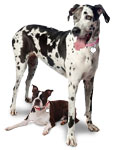 Annual physical examination
Annual physical examination
Performing a thorough annual physical examination on your canine patients provides an excellent opportunity to evaluate dogs for the presence of heart disease. The following factors provide important clues to cardiac status and can help detect congestive heart failure (CHF) in dogs:
- Weight and body condition: When cardiac disease occurs, cachexia (weight loss) is more likely to indicate CHF.
- Respiration: Evaluate rate and effort of respiration. Although normal respiratory rates vary depending on breed, temperature, and weight, a presentation at the 2009 ACVIM forum indicated that a resting respiratory rate higher than 35/minute in a dog (at home) is highly suggestive of heart failure. Accuracy can be further improved by determining a baseline respiration rate and watching for subsequent increases in individual dogs. When the resting respiratory rate increases by 25% to 50% or is above 35/minute, a diagnosis of CHF should be considered.
- Heart rate: CHF causes cardiac output to decrease, which in turn results in an increased heart rate. So, animals with relatively slow or normal heart rates (80 to 120 beats per minute) are less likely to have CHF than those with higher heart rates.
- Jugular distension: Include examination of the jugular veins. The presence of abnormal jugular pulses (extending more than one-third of the way up the neck) can indicate CHF in dogs.
- Mucous membranes and skin turgor: Evaluating mucous membranes in a dog provides an indicator of hydration status, peripheral perfusion, and tissue oxygenation.
- Abdominal distension: Palpate the abdomen to check for abdominal distension, which can be caused by hepatomegaly or ascites.
- Pulse abnormalities: Identifying arterial pulse abnormalities, such as hypokinetic (small stroke volume), hyperkinetic (large pulse pressure), and pulse deficits (arrhythmias) can help determine if a dog has CHF. Pulse deficits found in the femoral artery while simultaneously auscultating the heartbeat can be indicative of an arrhythmia.

 VETMEDIN is a registered trademark of Boehringer Ingelheim Vetmedica GmbH,
licensed to Boehringer Ingelheim Vetmedica, Inc.
VETMEDIN is a registered trademark of Boehringer Ingelheim Vetmedica GmbH,
licensed to Boehringer Ingelheim Vetmedica, Inc.